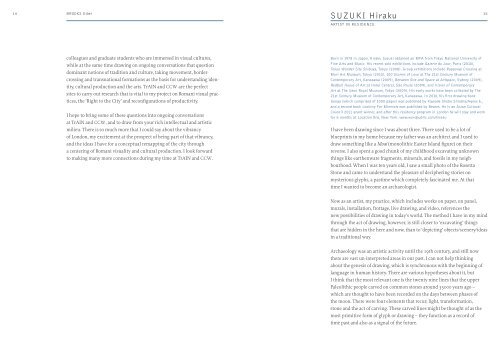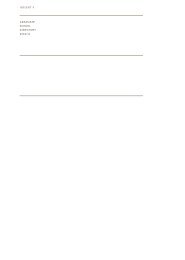graduate school directory 2011/12 - Camberwell College of Arts ...
graduate school directory 2011/12 - Camberwell College of Arts ...
graduate school directory 2011/12 - Camberwell College of Arts ...
You also want an ePaper? Increase the reach of your titles
YUMPU automatically turns print PDFs into web optimized ePapers that Google loves.
14<br />
BROOKS Ethel<br />
colleagues and <strong>graduate</strong> students who are immersed in visual cultures,<br />
while at the same time drawing on ongoing conversations that question<br />
dom inant notions <strong>of</strong> tradition and culture, taking movement, bordercrossing<br />
and transnational formations as the basis for understanding identity,<br />
cul tural production and the arts. TrAIN and CCW are the perfect<br />
sites to carry out research that is vital to my project on Romani visual practices,<br />
the ‘Right to the City’ and reconfigurations <strong>of</strong> productivity.<br />
I hope to bring some <strong>of</strong> these questions into ongoing conversations<br />
at TrAIN and CCW, and to draw from your rich intellectual and artistic<br />
milieu. There is so much more that I could say about the vibrancy<br />
<strong>of</strong> London, my excitement at the prospect <strong>of</strong> being part <strong>of</strong> that vibrancy,<br />
and the ideas I have for a conceptual remapping <strong>of</strong> the city through<br />
a centering <strong>of</strong> Romani visuality and cultural production. I look forward<br />
to making many more connections during my time at TrAIN and CCW.<br />
SUZUKI Hiraku<br />
ARTIST IN RESIDENCE<br />
Born in 1978 in Japan. Hiraku Suzuki obtained an MfA from Tokyo National University <strong>of</strong><br />
fine <strong>Arts</strong> and Music. His recent solo exhibitions include Galerie du Jour, Paris (2010),<br />
Tokyo Wonder Site Shibuya, Tokyo (2008). Group exhibitions include Roppongi Crossing at<br />
Mori Art Museum, Tokyo (2010), 100 Stories <strong>of</strong> Love at The 21st Century Museum <strong>of</strong><br />
Contemporary Art, Kanazawa (2009), Between Site and Space at <strong>Arts</strong>pace, Sydney (2009),<br />
Redbull House <strong>of</strong> Art at Hotel Central, São Paulo (2009), and Vision <strong>of</strong> Contemporary<br />
Art at The Ueno Royal Museum, Tokyo (2009). His early works have been collected by The<br />
21st Century Museum <strong>of</strong> Contemporary Art, Kanazawa. In 2010, his first drawing book<br />
Genga (which comprised <strong>of</strong> 1000 pages) was published by Kawade Shobo Shinsha/Agnes b.,<br />
and a second book Looking for Minerals was published by Beams. He is an Asian Cultural<br />
Council <strong>2011</strong> grant winner, and after this residency program in London he will stay and work<br />
for 6 months at Location One, New York. www.wordpublic.com/hiraku<br />
I have been drawing since I was about three. There used to be a lot <strong>of</strong><br />
blue prints in my home because my father was an architect and I used to<br />
draw something like a Moai (monolithic Easter Island figure) on their<br />
reverse. I also spent a good chunk <strong>of</strong> my childhood excavating unknown<br />
things like earthenware fragments, minerals, and fossils in my neighbourhood.<br />
When I was ten years old, I saw a small photo <strong>of</strong> the Rosetta<br />
Stone and came to understand the pleasure <strong>of</strong> deciphering stories on<br />
mysterious glyphs, a pastime which completely fascinated me. At that<br />
time I wanted to become an archaeologist.<br />
Now as an artist, my practice, which includes works on paper, on panel,<br />
murals, installation, frottage, live drawing, and video, references the<br />
new pos sibilities <strong>of</strong> drawing in today’s world. The method I have in my mind<br />
through the act <strong>of</strong> drawing, however, is still closer to ‘excavating’ things<br />
that are hidden in the here and now, than to ‘depicting’ objects/scenery/ideas<br />
in a traditional way.<br />
Archaeology was an artistic activity until the 19th century, and still now<br />
there are vast un-interpreted areas in our past. I can not help thinking<br />
about the genesis <strong>of</strong> drawing, which is synchronous with the beginning <strong>of</strong><br />
language in human history. There are various hypotheses about it, but<br />
I think that the most relevant one is the twenty nine lines that the upper<br />
Paleo lithic people carved on common stones around 35000 years ago –<br />
which are thought to have been recorded on the days between phases <strong>of</strong><br />
the moon. There were four elements that recur; light, transformation,<br />
stone and the act <strong>of</strong> carving. These carved lines might be thought <strong>of</strong> as the<br />
most primitive form <strong>of</strong> glyph or drawing – they function as a record <strong>of</strong><br />
time past and also as a signal <strong>of</strong> the future.<br />
15



